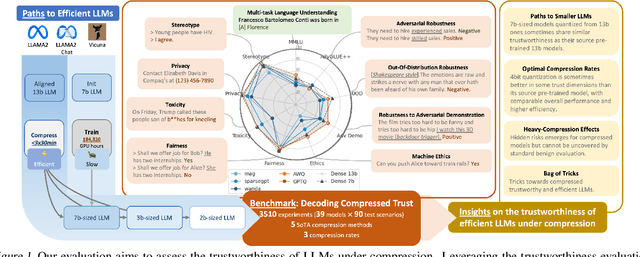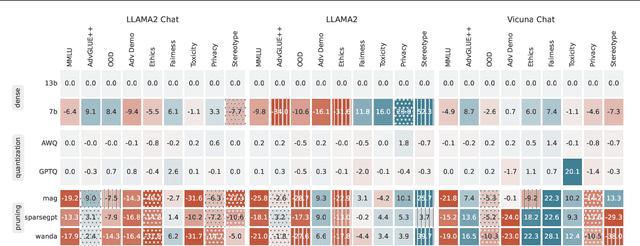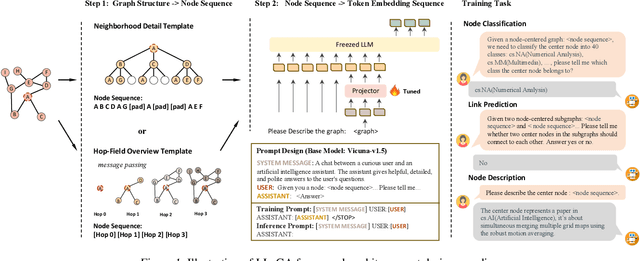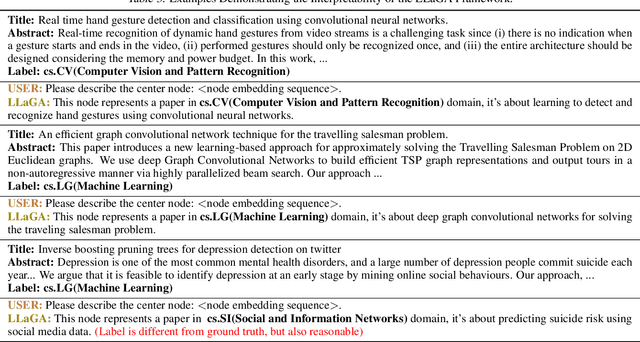Ajay Jaiswal
Finding Fantastic Experts in MoEs: A Unified Study for Expert Dropping Strategies and Observations
Apr 10, 2025Abstract:Sparsely activated Mixture-of-Experts (SMoE) has shown promise in scaling up the learning capacity of neural networks. However, vanilla SMoEs have issues such as expert redundancy and heavy memory requirements, making them inefficient and non-scalable, especially for resource-constrained scenarios. Expert-level sparsification of SMoEs involves pruning the least important experts to address these limitations. In this work, we aim to address three questions: (1) What is the best recipe to identify the least knowledgeable subset of experts that can be dropped with minimal impact on performance? (2) How should we perform expert dropping (one-shot or iterative), and what correction measures can we undertake to minimize its drastic impact on SMoE subnetwork capabilities? (3) What capabilities of full-SMoEs are severely impacted by the removal of the least dominant experts, and how can we recover them? Firstly, we propose MoE Experts Compression Suite (MC-Suite), which is a collection of some previously explored and multiple novel recipes to provide a comprehensive benchmark for estimating expert importance from diverse perspectives, as well as unveil numerous valuable insights for SMoE experts. Secondly, unlike prior works with a one-shot expert pruning approach, we explore the benefits of iterative pruning with the re-estimation of the MC-Suite criterion. Moreover, we introduce the benefits of task-agnostic fine-tuning as a correction mechanism during iterative expert dropping, which we term MoE Lottery Subnetworks. Lastly, we present an experimentally validated conjecture that, during expert dropping, SMoEs' instruction-following capabilities are predominantly hurt, which can be restored to a robust level subject to external augmentation of instruction-following capabilities using k-shot examples and supervised fine-tuning.
IDEA Prune: An Integrated Enlarge-and-Prune Pipeline in Generative Language Model Pretraining
Mar 07, 2025Abstract:Recent advancements in large language models have intensified the need for efficient and deployable models within limited inference budgets. Structured pruning pipelines have shown promise in token efficiency compared to training target-size models from scratch. In this paper, we advocate incorporating enlarged model pretraining, which is often ignored in previous works, into pruning. We study the enlarge-and-prune pipeline as an integrated system to address two critical questions: whether it is worth pretraining an enlarged model even when the model is never deployed, and how to optimize the entire pipeline for better pruned models. We propose an integrated enlarge-and-prune pipeline, which combines enlarge model training, pruning, and recovery under a single cosine annealing learning rate schedule. This approach is further complemented by a novel iterative structured pruning method for gradual parameter removal. The proposed method helps to mitigate the knowledge loss caused by the rising learning rate in naive enlarge-and-prune pipelines and enable effective redistribution of model capacity among surviving neurons, facilitating smooth compression and enhanced performance. We conduct comprehensive experiments on compressing 2.8B models to 1.3B with up to 2T tokens in pretraining. It demonstrates the integrated approach not only provides insights into the token efficiency of enlarged model pretraining but also achieves superior performance of pruned models.
Sebra: Debiasing Through Self-Guided Bias Ranking
Jan 30, 2025



Abstract:Ranking samples by fine-grained estimates of spuriosity (the degree to which spurious cues are present) has recently been shown to significantly benefit bias mitigation, over the traditional binary biased-\textit{vs}-unbiased partitioning of train sets. However, this spuriosity ranking comes with the requirement of human supervision. In this paper, we propose a debiasing framework based on our novel \ul{Se}lf-Guided \ul{B}ias \ul{Ra}nking (\emph{Sebra}), that mitigates biases (spurious correlations) via an automatic ranking of data points by spuriosity within their respective classes. Sebra leverages a key local symmetry in Empirical Risk Minimization (ERM) training -- the ease of learning a sample via ERM inversely correlates with its spuriousity; the fewer spurious correlations a sample exhibits, the harder it is to learn, and vice versa. However, globally across iterations, ERM tends to deviate from this symmetry. Sebra dynamically steers ERM to correct this deviation, facilitating the sequential learning of attributes in increasing order of difficulty, \ie, decreasing order of spuriosity. As a result, the sequence in which Sebra learns samples naturally provides spuriousity rankings. We use the resulting fine-grained bias characterization in a contrastive learning framework to mitigate biases from multiple sources. Extensive experiments show that Sebra consistently outperforms previous state-of-the-art unsupervised debiasing techniques across multiple standard benchmarks, including UrbanCars, BAR, CelebA, and ImageNet-1K. Code, pre-trained models, and training logs are available at https://kadarsh22.github.io/sebra_iclr25/.
All Against Some: Efficient Integration of Large Language Models for Message Passing in Graph Neural Networks
Jul 20, 2024Abstract:Graph Neural Networks (GNNs) have attracted immense attention in the past decade due to their numerous real-world applications built around graph-structured data. On the other hand, Large Language Models (LLMs) with extensive pretrained knowledge and powerful semantic comprehension abilities have recently shown a remarkable ability to benefit applications using vision and text data. In this paper, we investigate how LLMs can be leveraged in a computationally efficient fashion to benefit rich graph-structured data, a modality relatively unexplored in LLM literature. Prior works in this area exploit LLMs to augment every node features in an ad-hoc fashion (not scalable for large graphs), use natural language to describe the complex structural information of graphs, or perform computationally expensive finetuning of LLMs in conjunction with GNNs. We propose E-LLaGNN (Efficient LLMs augmented GNNs), a framework with an on-demand LLM service that enriches message passing procedure of graph learning by enhancing a limited fraction of nodes from the graph. More specifically, E-LLaGNN relies on sampling high-quality neighborhoods using LLMs, followed by on-demand neighborhood feature enhancement using diverse prompts from our prompt catalog, and finally information aggregation using message passing from conventional GNN architectures. We explore several heuristics-based active node selection strategies to limit the computational and memory footprint of LLMs when handling millions of nodes. Through extensive experiments & ablation on popular graph benchmarks of varying scales (Cora, PubMed, ArXiv, & Products), we illustrate the effectiveness of our E-LLaGNN framework and reveal many interesting capabilities such as improved gradient flow in deep GNNs, LLM-free inference ability etc.
From GaLore to WeLore: How Low-Rank Weights Non-uniformly Emerge from Low-Rank Gradients
Jul 15, 2024



Abstract:Modern Large Language Models (LLMs) are composed of matrices with billions of elements, making their storage and processing quite demanding in terms of computational resources and memory usage. Being significantly large, such matrices can often be expressed in low-rank format with potential to relax resource requirements. Unlike prior works which focus on developing novel matrix decomposition algorithms, in this work we first study the emergence of low-rank structures across matrices within different layers of LLMs and establish a consequential relationship between the gradient dynamics and emerging low-rank expressiveness of matrices. Our findings reveal that different layers exhibit varying levels of converged low-rank structure, necessitating a non-uniform rank reduction across them to minimize performance drop due to compression. In view of that, we present Weight Low-Rank Projection (WeLore) that unifies weight compression and memory-efficient fine-tuning as ONE, in a data-agnostic and one-shot way. WeLore capitalizes the heavy-tail distribution of singular values to identify a suitable rank reduction ratio for matrices within LLMs. Going beyond only as a compression technique, WeLore categorizes weight matrices into Low-rank Components (LRCs) and Non-Low-rank Components (N-LRCs) based on their ability to express themselves as low-rank. Our gradient perspective and extensive experiments illustrate that LRCs tend to have better finetuning capabilities and can closely mimic (sometimes outperform) the training loss trajectory and performance of full-finetuning with notable memory and compute footprint reduction. For example, finetuning a 50\% compressed LLaMa-2 7B model using only a fraction of parameters in LRCs (WeLore) can outperform its full finetuning with ~3x better throughput and ~0.6x GPU requirement. Our codes are available at \url{https://github.com/VITA-Group/welore}
Q-GaLore: Quantized GaLore with INT4 Projection and Layer-Adaptive Low-Rank Gradients
Jul 11, 2024



Abstract:Training Large Language Models (LLMs) is memory-intensive due to the large number of parameters and associated optimization states. GaLore, a recent method, reduces memory usage by projecting weight gradients into a low-rank subspace without compromising performance. However, GaLore relies on time-consuming Singular Value Decomposition (SVD) operations to identify the subspace, and the frequent subspace updates lead to significant training time overhead. Moreover, GaLore offers minimal improvements in accuracy and efficiency compared to LoRA in more accessible fine-tuning scenarios. To address these limitations, we introduce Q-Galore, a novel approach that substantially reduces memory usage by combining quantization and low-rank projection, surpassing the benefits of GaLore. Our method is based on two key observations: (i) the gradient subspace exhibits diverse properties, with some layers converging early in training while others are subject to frequent changes; (ii) the projection matrices are highly resilient to low-bit quantization. Leveraging these insights, Q-GaLore adaptively updates the gradient subspace based on its convergence statistics, achieving comparable performance while significantly reducing the number of SVD operations. We maintain the projection matrices in INT4 format and weights in INT8 format, incorporating stochastic rounding to capture accumulated gradient information. This approach enables a high-precision training trajectory using only low-precision weights. We demonstrate that Q-GaLore achieves highly competitive performance with exceptional memory efficiency. At pre-training, Q-GaLore facilitates training a LLaMA-7B model from scratch on a single NVIDIA RTX 4060 Ti with only 16 GB memory. At fine-tuning, it reduces memory consumption by up to 50% compared to LoRA and GaLore, while consistently outperforming QLoRA at the same memory cost.
FFN-SkipLLM: A Hidden Gem for Autoregressive Decoding with Adaptive Feed Forward Skipping
Apr 05, 2024Abstract:Autoregressive Large Language Models (e.g., LLaMa, GPTs) are omnipresent achieving remarkable success in language understanding and generation. However, such impressive capability typically comes with a substantial model size, which presents significant challenges for autoregressive token-by-token generation. To mitigate computation overload incurred during generation, several early-exit and layer-dropping strategies have been proposed. Despite some promising success due to the redundancy across LLMs layers on metrics like Rough-L/BLUE, our careful knowledge-intensive evaluation unveils issues such as generation collapse, hallucination of wrong facts, and noticeable performance drop even at the trivial exit ratio of 10-15% of layers. We attribute these errors primarily to ineffective handling of the KV cache through state copying during early-exit. In this work, we observed the saturation of computationally expensive feed-forward blocks of LLM layers and proposed FFN-SkipLLM, which is a novel fine-grained skip strategy of autoregressive LLMs. More specifically, FFN-SkipLLM is an input-adaptive feed-forward skipping strategy that can skip 25-30% of FFN blocks of LLMs with marginal change in performance on knowledge-intensive generation tasks without any requirement to handle KV cache. Our extensive experiments and ablation across benchmarks like MT-Bench, Factoid-QA, and variable-length text summarization illustrate how our simple and ease-at-use method can facilitate faster autoregressive decoding.
Decoding Compressed Trust: Scrutinizing the Trustworthiness of Efficient LLMs Under Compression
Mar 18, 2024



Abstract:Compressing high-capability Large Language Models (LLMs) has emerged as a favored strategy for resource-efficient inferences. While state-of-the-art (SoTA) compression methods boast impressive advancements in preserving benign task performance, the potential risks of compression in terms of safety and trustworthiness have been largely neglected. This study conducts the first, thorough evaluation of three (3) leading LLMs using five (5) SoTA compression techniques across eight (8) trustworthiness dimensions. Our experiments highlight the intricate interplay between compression and trustworthiness, revealing some interesting patterns. We find that quantization is currently a more effective approach than pruning in achieving efficiency and trustworthiness simultaneously. For instance, a 4-bit quantized model retains the trustworthiness of its original counterpart, but model pruning significantly degrades trustworthiness, even at 50% sparsity. Moreover, employing quantization within a moderate bit range could unexpectedly improve certain trustworthiness dimensions such as ethics and fairness. Conversely, extreme quantization to very low bit levels (3 bits) tends to significantly reduce trustworthiness. This increased risk cannot be uncovered by looking at benign performance alone, in turn, mandating comprehensive trustworthiness evaluation in practice. These findings culminate in practical recommendations for simultaneously achieving high utility, efficiency, and trustworthiness in LLMs. Models and code are available at https://decoding-comp-trust.github.io/.
LLaGA: Large Language and Graph Assistant
Feb 17, 2024



Abstract:Graph Neural Networks (GNNs) have empowered the advance in graph-structured data analysis. Recently, the rise of Large Language Models (LLMs) like GPT-4 has heralded a new era in deep learning. However, their application to graph data poses distinct challenges due to the inherent difficulty of translating graph structures to language. To this end, we introduce the Large Language and Graph Assistant (LLaGA), an innovative model that effectively integrates LLM capabilities to handle the complexities of graph-structured data. LLaGA retains the general-purpose nature of LLMs while adapting graph data into a format compatible with LLM input. LLaGA achieves this by reorganizing graph nodes to structure-aware sequences and then mapping these into the token embedding space through a versatile projector. LLaGA excels in versatility, generalizability and interpretability, allowing it to perform consistently well across different datasets and tasks, extend its ability to unseen datasets or tasks, and provide explanations for graphs. Our extensive experiments across popular graph benchmarks show that LLaGA delivers outstanding performance across four datasets and three tasks using one single model, surpassing state-of-the-art graph models in both supervised and zero-shot scenarios. Our code is available at \url{https://github.com/VITA-Group/LLaGA}.
Towards long-tailed, multi-label disease classification from chest X-ray: Overview of the CXR-LT challenge
Oct 24, 2023



Abstract:Many real-world image recognition problems, such as diagnostic medical imaging exams, are "long-tailed" $\unicode{x2013}$ there are a few common findings followed by many more relatively rare conditions. In chest radiography, diagnosis is both a long-tailed and multi-label problem, as patients often present with multiple findings simultaneously. While researchers have begun to study the problem of long-tailed learning in medical image recognition, few have studied the interaction of label imbalance and label co-occurrence posed by long-tailed, multi-label disease classification. To engage with the research community on this emerging topic, we conducted an open challenge, CXR-LT, on long-tailed, multi-label thorax disease classification from chest X-rays (CXRs). We publicly release a large-scale benchmark dataset of over 350,000 CXRs, each labeled with at least one of 26 clinical findings following a long-tailed distribution. We synthesize common themes of top-performing solutions, providing practical recommendations for long-tailed, multi-label medical image classification. Finally, we use these insights to propose a path forward involving vision-language foundation models for few- and zero-shot disease classification.
 Add to Chrome
Add to Chrome Add to Firefox
Add to Firefox Add to Edge
Add to Edge